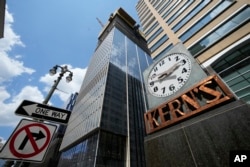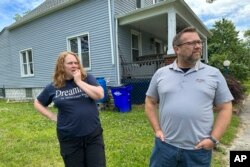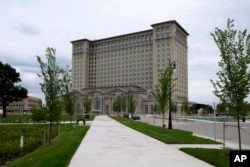Mike Berent has spent far more than 27 yrs rushing into burning houses in Detroit, pulling people today to security and guaranteeing his fellow firefighters get out alive.
But as the 52-calendar year-old Detroit Hearth Section lieutenant approaches required retirement at age 60, he says one particular thing is clear: He will have to have to retain working to make finishes meet.
“I’m hoping to set as considerably income away as I can,” explained Berent, who also is effective in gross sales. “A second work affords you to have a tiny bit of further.”
Countless numbers of city workers and retirees lost huge on July 18, 2013, when a point out-appointed manager created Detroit the largest U.S. town to file for personal bankruptcy.
A ten years later, the Motor Town has risen from the ashes of insolvency, with balanced budgets, profits will increase and thousands and thousands of pounds socked away. But Berent and other people who used a long time on Detroit’s payroll say they can not enable but experience remaining guiding.
“You come to be a firefighter simply because which is your passion and you’ll make a first rate dwelling. You would retire with a excellent pension,” explained Berent, who informed The Related Push that his regular monthly pension payments will be a lot more than $1,000 lessen than envisioned thanks to the individual bankruptcy.
Berent’s city-funded health and fitness care also finishes with retirement, five years ahead of he is eligible for Medicare.
“I don’t see us at any time having overall health care back,” he stated. “It really is heading to have to occur out of our pensions.”
The architect of the individual bankruptcy submitting was Kevyn Orr, a law firm hired by then-Governor Rick Snyder in 2013 to correct Detroit’s finances deficit and its underfunded pensions, health and fitness care expenditures and bond payments.
Detroit exited bankruptcy in December 2014 with about $7 billion in debt restructured or wiped out and $1.7 billion established aside to increase city companies. Enterprises, foundations and the condition donated a lot more than $800 million to soften the pension cuts and preclude the sale of town-owned artwork.
The pension cuts were essential, Orr insisted.
“I’ve go through about the ache, the quite serious ache,” he told the AP. “But the solutions of what was likely to transpire — just on the math — would have been noticeably worse.”
In 2013, Detroit experienced some 21,000 retired staff who ended up owed gains, with underfunded obligations of about $3.5 billion for pensions and $5.7 billion for retiree well being coverage.
In the months before the bankruptcy, condition-backed bond dollars aided the city satisfy payroll for its 10,000 workforce.
“Those people issues had been very well on their way several years or decades just before we received there,” Orr explained.
Daniel Varner, the president and main govt of Goodwill Industries of Bigger Detroit, which presents on-the-job schooling and qualified labor to businesses, named the individual bankruptcy filing “heartbreaking.”
“In some approaches, it represented the failure of all of us who had been working so tricky to reach the [city’s] renaissance,” Varner said. “On the flip aspect … perhaps this is the fresh commence? I imagine we have been building fantastic progress.”
The city, which was topic to condition oversight and a state-monitored paying plan for many years immediately after the personal bankruptcy filing, has noted nine consecutive many years of balanced budgets and robust money surpluses.
Mike Duggan was elected mayor and took business in 2014. Hoping to slow the exodus of people today and businesses from Detroit — its populace plummeted from about 1.8 million in 1950 to below 700,000 in 2013 — and increase the tax base, Duggan’s administration started pushing enhancements to metropolis products and services and high quality of everyday living.
Additional than 24,000 deserted homes and other vacant buildings were being demolished, mostly working with federal money. Countless numbers extra had been renovated and place on the current market to attract or maintain people in Detroit.
“Incredibly little of our restoration had anything to do with the bankruptcy,” Duggan reported Tuesday, pointing to business developments and neighborhood enhancement initiatives. “The financial improvement strategy is what is actually driving it.”
Jay Aho and his wife, Tanya, have seen improvements in their eastside neighborhood. Together nearby Sylvester Street, about 50 percent a dozen vacant homes have been torn down and just just one ramshackle property continues to be, with peeling siding, sagging roof and surrounded by waistline-large weeds, trees and a flourishing rose bush. Rabbits, deer and pheasants have began to look in the grass and weed-stuffed vacant tons.
“We reward from having a lot of open up area, wonderful environment,” stated Jay Aho, 49.
Born in southwest Detroit, 32-yr-outdated Arielle Kyer also sees enhancements.
“There were no parks like what there are now,” she mentioned at a ribbon-cutting ceremony for a new splash pad attended by Duggan. “Every thing is distinctive.”
Downtown, boutique lodges and upscale restaurants have sprung up, and a 685-foot (208-meter) skyscraper under development is predicted to host a resort, a restaurant, retailers, places of work and residential units.
Corktown, a neighborhood just east of downtown, got a improve in 2018 when Ford Motor Co. acquired and commenced renovating the hulking Michigan Central practice station, which for years was a symbol of the city’s blight. The constructing will be component of a campus concentrating on autonomous motor vehicles.
Ford’s go has captivated other investment decision, in accordance to Aaron Black, the common supervisor of the close by $75 million Godfrey Lodge, which is scheduled to open this year and whose owners also are acquiring houses in the neighborhood.
“The [city’s] brand name may have been dented,” Black said. “The brand name could have been tarnished, but Detroit is head and shoulders higher than a great deal of other competitive cities.”
Some warn from much too a lot optimism.
Detroit’s two pension devices have been generating regular monthly payments to retirees without any contributions from the town for the earlier ten years. That is set to modify following calendar year when the city will be demanded to resume contributions from a metropolis-designed fund that now stands at about $470 million.
Detroit’s Chief Fiscal Officer Jay Increasing says both of those pension methods are improved funded than a decade ago. But Leonard Gilroy, senior controlling director of the Washington-primarily based Motive Foundation’s Pension Integrity Project, suggests his data exhibits the systems’ funding concentrations in close proximity to in which they ended up in 2013.
“It’s a large instant for the metropolis that provides complicated potential fiscal worries to prevent more deterioration of the pensions,” Gilroy reported. “They are obtaining the keys back to fund their pension system, which would be a enormous obligation if these plans ended up fully funded, and is that substantially extra of a challenge offered their fragile, underfunded condition.”











More Stories
Arbitrage Opportunities In Financial Markets
Options Trading And Volatility
Seo Strategies For Financial Institutions And Services